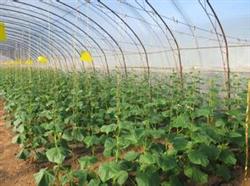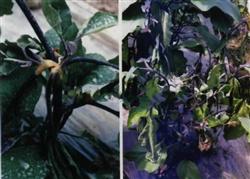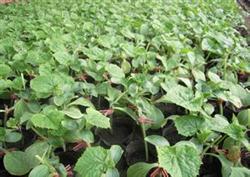Seed Cultivation--Seedling Cultivation Technique of Cucumber in Spring Greenhouse with Multi-layer Cover

First, shed structure. The span of the greenhouse had better be 6-8 meters, and the greenhouse film was buckled in early November. There was a small arch shed of 1.5 meters, covering a wide greenhouse film of 3 meters. At night, the small arch shed was covered with a layer of thick grass grass, and the grass grass was covered with an old greenhouse film, which greatly enhanced the heat preservation performance. Cucumbers can also be planted in the shed after raising seedlings. Second, the preparation of nutritious soil. Take 60% of the fertile soil that has not planted cucurbitaceae crops and 40% of the mature organic fertilizer. Add 15 kg of rotten and mashed chicken manure, 3 kg of superphosphate, 2 kg of urea, 1-1.5 kg of potassium sulfate per cubic meter, and 100 grams of carbendazim can be added to each cubic meter. Third, sowing 1, seed selection: select varieties with disease resistance, strong stress resistance, good commercial characters and high yield. Jinchun 3, Jinyou 3 and Leiyu platinum bars can be selected for cultivation in solar greenhouse in winter and spring, and Leting autumn melon, Cuiyu and Tangshan autumn melon can be selected for spring open field cultivation. 2, seed treatment: soak the seeds in 55 ℃ warm water for 10-15 minutes, and constantly stir until the water temperature drops to room temperature, then soak the seeds for 3-4 hours, then scrub the seeds repeatedly, rinse the mucus with clean water and dry them to promote germination, which can prevent scab, anthrax, virus and sclerotiorum. Soak the seeds with 50% carbendazim 500 times solution for 1 hour and remove them for budding to prevent Fusarium wilt and scab. The treated seeds were wrapped in a wet cloth and germinated for 1-2 days under the condition of 25-30 ℃. When the seeds "exposed white tip", they were put under the condition of 0-20 ℃ for 1-2 days. 3. Sowing: wait for most seeds to germinate. Solar greenhouse winter and spring stubble in the first half of January, winter stubble from late September to early October. Spring stubble in open field was sown from mid-March to early April, and autumn stubble from late June to early July. Soak the seedbed soil one day before sowing. Before sowing, sprinkle a thin layer of fine fluvo-aquic soil on the bed, and then add a little fine sand, so that it can be spread evenly, the sowing amount per mu is between 140 and 160 grams. After sowing, the bed is covered with 1 cm thick methyl topiramate soil, then covered with plastic film to keep warm and moisturizing. 4. Nursery bed management 1. Seedling management: buckle strict small arch greenhouse film during the day after sowing. Cover it with thick grass and old greenhouse film at night. (appropriate early cover and late uncover), during this period, the natural temperature of the greenhouse during the day is up to 25-30 ℃, which is more suitable and does not need ventilation. Remove the plastic film after emergence, remove the old greenhouse film and grass mulch after sunrise during the day, and then uncover the small arch greenhouse film later to enhance the light. At 4: 00 p. M., cover the small arch shed and grass clover, the old shed film. In order to prevent overgrowth, the temperature should be kept a little lower after emergence, which should be controlled at about 20 ℃ during the day and 8-15 ℃ at night, and slightly lower the temperature 3-5 days before seedling division, so that the seedling leaves are thick, the leaf color is dark green, the root system is developed, and the seedling is slow and fast after seedling division. When the seedling grows to 2 true leaves, the seedling is divided in time, the seedling is early and inconvenient to operate, and it is easy to hurt the root when it is late to affect the survival rate of the seedling. The seedling bed was watered one day before the seedling was divided, and the seedlings were planted in a nutrition bowl the next day, and methyl topiramate was poured through to prevent seedling diseases. 2. Post-seedling management: in order to prevent the seedling from wilting, it is necessary to cover the small arch shed for shade during the day, open the small greenhouse film during the day after slowing the seedling, cover the small greenhouse film, grass mulch and old greenhouse film at night, and keep the temperature at about 28 ℃ in the daytime, 10-18 ℃ at night, and the lowest not less than 8 ℃. It is found that the bowl soil is dry, the seedling age is 40-45 days, and the three leaves can be planted with one heart.
- Prev

Control of Diseases and insect pests of eggplant in early Spring
Eggplant, which is raised in early spring, mainly controls soil-borne diseases such as quenching, blight and Sclerotinia sclerotiorum. Seedbed soil disinfection, using 50 kg seedbed soil plus 20 g 68% Jinlei water dispersible granules and 10 ml 2.5% suspending agent can be sifted and mixed with a nutrition bowl or laid on the seedling bed. Spraying 0.1%-0.2% potassium dihydrogen phosphate at seedling stage.
- Next

When is it good to plant cucumber in small arch shed in spring and early maturity?
When to plant cucumber in small arch shed in spring? How to make it slow and grow fast? The suitable planting period of cucumber cultivated in plastic film shed was the last ten days of March. Cucumber seedling slow speed after planting, growth is good or bad by many environmental factors, the most important of which is the root growth.
Related
- Where is it suitable to grow horseradish in China? it is expected to see the middle altitude horseradish in Alishan.
- How to prevent tomato virus disease reasonably? (Control methods included)
- Many people like to plant towel gourd on the balcony. What are the main points of this method and management?
- What crops can chili peppers be mixed with?
- Fertilization techniques and matters needing attention in Tomato
- What are the grafting techniques for peach seedlings in spring?
- Harm and control methods of root swelling disease of Chinese cabbage
- What are the pests of sweet potatoes? How to prevent and cure it?
- Symptoms, causes and Control methods of navel Rot in Tomato
- The cause of "Cucumber rotten bibcock" in Farmers' planting Cucumber and its Control Plan

